#IPLaw – Rather seizure for counterfeiting or discovery procedure?
Let’s start with a story that can be that of your company.
After long efforts, the company may have products recognized by its clientele as qualitative, including its distinctive signs and its constant search to offer high-performance products.
Whenever the customer recognizes the color, the name, the form, he expects to renew a more than satisfactory experience that he has already had with the products of the same company, and may expect to have additional advanced technical innovations.
Given the success of the first company, a second competing company may consider investing in the same market and offering similar products. Therefore, there is a limit not to be crossed, the freedom of the second company ending at the frontier of the intellectual property rights of the first one when they are regularly established.
If the competing company uses an identical or similar distinctive sign, to be compared to a registered trademark, there is a dispute on grounds of trademark infringement. If it is a technological innovation protected by a patent, it is rather a patent infringement.
But how to provide admissible proof that my competitor has reproduced my mark or my innovation (French procedures)?
1 °) The holder can mandate a bailiff to make a purchase statement. In essence, the bailiff buys the product and places it under seal.
This evidence is limited because there are usually a lot of commercial intermediaries. In addition, it is inoperative in most cases of infringement of a process patent.
2 °) The “royal” way is the seizure for counterfeiting. As a historical procedure in France, and implemented in Europe by a so-called “enforcemment” directive (2004/48), the seizure for counterfeiting allows the holder of intellectual property rights regularly registered, to request from the competent judge of the Court of First Instance, on the basis of evidence and the industrial property title in its possession, to issue an order for seizure.
On the basis of this order, the Patent Attorney and a bailiff visit the premises of the competitor to make the seizure.
It can be a seizure of samples, industrial documents, accounting documents, descriptive seizure, photos of installations … as provided in particular Article L. 615-5 of the Intellectual Property Code.
The procedure is very framed. Form defects can cancel the seiure. The appelant must commence an action on the merits within 20 business days or 31 calendar days after the seizure. If not, the seizure will be canceled.
In addition, the seizure is made by agents who are bound by professional secrecy, so much so that the secrecy of the business is not violated.
An abusive seizure engages the responsibility of the appelant, who will have to pay damages.
The purpose of the seizure for counterfeiting is to be able to provide substantial evidence of infringement of the rights from within the defendant’s company. Revenue from counterfeiting can be deducted as well as the product distribution chain.
Even if the procedure seems invasive, it is very framed so that fundamental rights are not violated.
Other jurisdictions such as those in the United States are based on so-called discovery procedures, where parties must exchange as much information as needed without hiding anything. In general, the most wealthy parties flood the other parties with an infinity of documents to be reviewed by the advisors. The less wealthy parties should take of their time, which would have been used for production, to search for the documents and send them to the other parties.
In comparison, the seizure for counterfeiting would go to the heart of the issue and enable to quickly collect information that is needed, unlike the discovery procedure.
We remain at your disposal for any additional clarification you may need.




Leave a Reply
Want to join the discussion?Feel free to contribute!